Monitors Baby's Quiet Sounds Video Monitor Check price and buy @ amazon.com  Secure Starlight Monitor Check price and buy @ amazon.com |
Cabinet Locks & Straps Magnetic Tot Loc Four Lock Assembly Check price and buy @ amazon.com |
Edge & Corner Guards Expandable Table Edge Bumper-Medium Check price and buy @ amazon.com |
Gates Walk-Through Stair Gate Check price and buy @ amazon.com  Railnet Check price and buy @ amazon.com |
Thermometers Vicks Speed-Read Digital Thermometer Check price and buy @ amazon.com |
Keeping Baby Safe - Buying Guide for Babyproofing your Home
by Jane Snyder, Baby EditorGeneral Baby Safety
Thinking about baby safety doesn't necessarily come naturally to parents and, in fact, might seem like yet another overwhelming and intimidating task related to bringing up baby. Fortunately, babyproofing is something parents can--and should--take care of before baby even arrives, when you do not yet have the day-to-day care of a new infant as your first priority. You might consider it as the warm-up before the big game--a time to get into the right mindset for parenting and get comfortable with your equipment and strategy. Like many things, you should rely on instinct, but here are some general guidelines to help you make your home a safer place for your bundle of joy.
The guidelines below contain very specific suggestions about how to babyproof your home. However, it's also helpful to keep some basic things about baby development in mind as you consider ways to make baby's surroundings safe:
• A new infant, though not mobile, requires safe equipment ( car seats, cribs, strollers, monitors).
• Once a baby can push herself up on her hands or roll over (around 3 to 6 months), you will need to make sure there is nothing within her reach in or above the crib or on a playmat that may be hazardous.
• When a baby learns to creep or crawl (around 7 to 9 months), the area in need of babyproofing expands exponentially. You may have to develop babyproof "zones" in highly frequented areas of the home--rooms that are safe for baby and are blocked off from the rest of the home by gates or other equipment. Staircases now become a hazard, and some experts suggest that the bathroom and kitchen should be completely off-limits to mobile children, due to the difficulties involved in making those areas safe for baby.
• A walking child can get much farther than a crawling child and can do so much faster. At this stage of the game (around 10 to 14 months) you will need to be especially vigilant about watching your child and making sure off-limits areas are well guarded by gates or other barricades. An upright child can also reach much higher than a crawling toddler, so the area that must be babyproof expands vertically as well as horizontally.
Basic Household Safety
"Better safe than sorry" is the best approach to adopt when it comes to making your home a safer place for your baby. The best way to assess what could pose potential hazards for your child is to see your home from a child's point of view, quite literally. Start by getting down on your hands and knees and explore your home from that vantage point. When you view things from this perspective, it will probably become quite obvious to you just how dangerous that coffee table corner is or how easy it would be for a baby or toddler to stick curious fingers into an electrical socket. Below is a checklist of things you should do in every room in your house.
• Use socket guards for all unused electrical sockets.
• Use safety locks on all windows.
• Put coins, keys, matches, batteries, paper clips, ashtrays, purses, and other small items out of your child's reach.
• Place safety latches on all cupboards and closets.
• Install smoke detectors in all sleeping areas.
• Install a carbon monoxide detector.
• Use corner cushions to protect your child from sharp corners.
• Use cord shorteners to avoid exposure to window cords and wires in the house.
• Secure gates at top and bottom of all stairways.
• Eliminate baby's access to the bathtubs, showers, toilets, swimming pools, and hot tubs.
• Make sure cosmetics, perfume, aftershave, and other toiletries are out of reach.
• Position pet food and the litter box out of baby's way.
• Post the number of your local poison control center next to telephones along with a list of other emergency numbers--such as the ER, pediatrician, grandparents and other close relatives, and neighbors.
• Stow cleaning products, paint, electrical tools, and exercise equipment out of baby's reach.
• Keep plastic wrap and plastic bags out of baby's reach.
Living Room/Family Room/Nursery
• Place knickknacks on a high shelf.
• Use a fireplace screen that a baby cannot tip over, store fire utensils and matches out of baby's reach, and cushion the corners of fireplace edges with padding or guards.
• Use socket guards for all unused electrical sockets.
• Cushion the edges of tables, desks, or other furniture with padding or guards.
• Do not hang mobiles or other toys over the corner or sides of a playard once baby can push up on her hands, as this could present a strangulation hazard.
• To prevent your toddler from hurting themselves climbing into or out of a playard, don't leave them in a mesh playard with the drop side down, and keep the drop side of a playard up even when your child is not in it. Do not leave children unattended in a playpen.
• Do not use use a playard with holes in the sides, as this could entrap a child's limbs or head.
• Avoid locking mechanisms on toy chests that could lead to pinched fingers or accidental closures.
Bathroom
Many experts suggest that babies and toddlers should not be allowed in the bathroom at all (except at bathtime or potty training sessions), as young children can drown in even the smallest amounts of water. However, because toddlers and crawlers are quite curious once they are up and moving on their own, experts suggest that you take the following safety precautions:
• Keep the toilet lid down and secure it with a latch and do not allow children to play with the water in the bowl. An open toilet bowl presents a potential drowning hazard (not to mention a germ hazard).
• Do not leave water in the bathtub when it is not in use. Children can drown in as little as 2 to 3 inches of water.
• Do not leave a child unattended in the bathtub or rely on an older sibling to supervise.
• Use nonskid mats in the bathtub to prevent slipping.
• Check to see that the suction cups on a bath seat are securely attached to the bath seat and tub surface.
• Never use the baby bath seat in a non-skid, slip-resistant bathtub because the suction cups may not adhere to the bathtub surface.
• Do not rely on bath seats to keep baby safe in the bath.
• Keep the medicine cabinet locked and keep all medications in childproof containers.
• Move all soaps, shampoos, bath gels, razors, and other toiletries out of reach of children.
• Before placing your baby in the bathtub, make sure you have everything you need to bathe your baby near you to prevent having to turn away from baby to fetch it later.
• Test the temperature of the water before bathing your baby by using your wrist or elbow, and remember that babies may not be able to tolerate the same water temperature as an adult. The correct temperature should be between 96 and 100 degrees Farenheit.
• Place soft or inflatable covers over tub faucets to prevent bumps and bruises.
Dining Room
• Always use all restraining straps provided on a highchair - both the waist strap and the strap that goes between the legs. Injuries or even strangulation can occur from unrestrained children slipping down under the highchair tray.
• Make sure that the locking device on a folding highchair is fully engaged.
• Don't allow your child to stand up in a highchair or an older child to hang onto a highchair while baby is in it.
• Place the highchair far enough away from the table, counter, or wall to prevent the child using that surface to push off and tip the chair over.
• When seating a child at a table, use place mats instead of tablecloths, in case they succeed in pulling the tabletop items off the table.
• Add sharp knives to place settings only after adults are seated.
• Use plastic plates and glasses for children.
• Be sure that your china and silverware are stored away from your baby's curious grasp.
Kitchen
The kitchen, like the bathroom, is full of potential hazards. It may be best to block access to the kitchen with a safety gate.
• Never leave babies or toddlers alone in the kitchen.
• Do not let your baby play on the floor by the stove while you are cooking.
• Use the back stove burners when possible. When using the front burners, turn the pot handles toward the back of the stove so that children cannot grab them.
• Install cabinet and drawer latches and locks to prevent your child from finding items that may present a choking hazard.
• Keep all dishwashing liquids and cleaning agents in locked or latched cabinets.
• Keep sharp and potentially dangerous items out of reach.
Safety Gates
When your baby starts to crawl, explore, or use a walker, it's time to install gates wherever potential hazards may be present around your home. At the top of stairs, at the bottom of stairs, and in between rooms, safety gates act as barricades that communicate which areas are off-limits for your little scooter. When purchasing gates for your home, there are several things to keep in mind: types of gates, features, and safety.
Types of Gates
Pressure-mounted gates: The two sliding panels of a pressure-mounted gate adjust to the dimensions of the doorway and a locking mechanism supplies the force to wedge the gate in place. These gates are typically used between rooms, but should not be used at the top or bottom of stairs.
Wall-mounted gates: This type of gate is mounted with screws directly into the wall and therefore has the ability to withstand more than pressure-mounted styles. Some styles have a special swing-stop mechanism to prevent the gate from swinging out over the stairs. Wall-mounted gates can be used at the top and bottom of stairs and at window openings.
Yard gates: Yard gates have expandable panels to form a fairly large area for your child to play in and are perfect for creating an exclusive area for your toddler outdoors. Typically, every other panel of a yard gate opens for easy access.
Available Features
• One-hand release allows you to open and lock a gate with one hand. This is great for times when you are carrying a baby (and that is sure to be often).
• Dual-direction swinging allows you to open the gate in either direction.
• Expandable gates can fit doorways and openings of different sizes.
• See-through gates allow you full vision of baby through widely spaced bars or mesh for better supervision.
• Installation kits help in mounting gates on various surfaces.
• Extension kits allow gates to expand to fit openings larger than standard-size doorways and windows.
• Gates come in various materials that complement any décor--wooden, plastic, plastic-coated steel, and soft mesh.
Safety Tips for Gate Usage
• Do not install pressure-mounted gates at the top of stairways, as they cannot withstand as much pressure as wall-mounted gates.
• Choose a gate with a straight top edge and rigid bars or a mesh screen, or an accordion-style gate with small (less than 1.5 inches) V-shaped and/or diamond-shaped openings.
• Discontinue using gates when your child is 36 inches tall or is 2 years old. A gate should never be less than three quarters of your child's height, since they can probably climb a gate that is not high enough.
• When installing gates with expanding pressure bars, install the bar side away from baby, since pressure bars can be used by children as toeholds to climb over a gate.
• Follow installation instructions and anchor the safety gate firmly in the doorway or stairway.
• Always close the gate behind you when leaving the room and never leave your child unsupervised.
• Do not use older models of gates that are not certified for safety. They are more prone to be hazardous.
Sleep Safety
Crib and Sleep Safety
As adults, we consider sleep such a natural part of everyday life that we often don't give it much thought (except, perhaps, that we'd like more of it). However, because of the risk of Sudden Infant Death Syndrome (SIDS), you should definitely give careful thought to how and where your baby sleeps. Though medical researches have not found one specific cause of SIDS, they have determined several factors that most likely contribute to these tragic infant deaths. As a result, the U.S. Consumer Product Safety Commission, the American Academy of Pediatrics, and the National Institute of Child Health and Human Development have developed the following safe bedding practices for infants:
• Place baby on his or her back on a firm, tight-fitting mattress in a crib that meets current safety standards.
• Remove pillows, quilts, comforters, sheepskins, stuffed toys, and other soft products from the crib.
• Consider using a sleeper or other sleep clothing as an alternative to blankets, with no other covering.
• If using a blanket, place baby's feet at the foot of the crib. Tuck a thin blanket around the crib mattress, reaching only as far as the baby's chest.
• Make sure your baby's head remains uncovered during sleep.
• Do not place baby on a waterbed, sofa, soft mattress, pillow, or other soft surface to sleep.
In addition to the guidelines above, the Consumer Product Safety Commission also suggests that an infant's crib should have:
• A firm, tight-fitting mattress so a baby cannot get trapped between the mattress and the crib.
• No missing, loose, broken, or improperly installed screws, brackets, or other hardware on the crib or mattress support.
• No more than 2.38 inches (about the width of a soda can) between crib slats so a baby's body cannot fit through the slats; no missing or cracked slats.
• No corner posts over 0.06-inch high so a baby's clothing cannot catch.
• No cutouts in the headboard or footboard so a baby's head cannot get trapped.
Monitors
Monitors are an extra pair of ears or eyes when it comes to looking out for baby. They allow parents and caregivers to keep tabs on a sleeping infant while working around the house or even outdoors. Although a monitor allows parents and caregivers more freedom and flexibility, it is important to remember that it does not replace adult supervision.
Monitors are actually a set of small radio transmitters: a base transmitter that is placed in the nursery near your infant and a receiver transmitter that is carried along with you. It is important for you to test and establish the operating range of the monitor by testing the unit in different room combinations, as obstructions caused by terrain and walls, and interference from other devices can cause static and unclear reception. If you're living in a densely populated area or high-rise apartment building, you'll want to look for models that offer more than one channel so that you can change channels when you get interference from a neighbor's portable phone or remote-control toy. On the other hand, if you know you'll want to be outside working in your garden or going longer distances with the receiver portion of your monitor, you'll want to get a high-range monitor (i.e. 900 MHz). Monitors operate on batteries, electricity, or a combination of both, and many are rechargeable and do not need batteries.
Types of Monitors
• Audio monitors transmit sound only. They may have multiple channels to minimize interference, a low-battery indicator, and volume control. Some monitors have a portable receiver that can be clipped on and taken wherever you go.
• Video monitors allow you to actually see and hear your child on a TV screen. Some monitors utilize infrared technology that allows you to see the nursery, even in total darkness.
• Sound-and-light audio monitors have a special LED display that allows you to view the sound level. In addition to standard features, most have an out-of-range signal light, too.
• Intercom monitors allow you to communicate with others in the house with just the push of a button, as well as transmitting baby's sounds. Some feature sound lights that let you "see" when baby stirs.
Monitor Safety Tips
• Do not use a monitor to justify leaving your child alone while playing. Parental supervision is essential.
• Do not place near water. As with any electrical gadget, monitors present shock hazards if misused.
• Always follow manufacturer's instructions on placement and usage of monitors.
• Handle monitors with care. Do not carry the device by the antenna, as they are fragile.
• Remember to place the monitor up high where other children cannot disturb it.
Car Seats
Dealing with car seats is a complicated and important business. That's why we've developed a Car Seat Buying Guide to help you figure out which car seat is the best one for you. In addition, the NHSTA (National Highway Safety Transportation Administration) suggests that you ask yourself the following car seat safety questions and adhere to the basic safety tips below.
• Does your child ride in the back seat? The back seat is generally the safest place in a crash. If your vehicle has a passenger air bag, it is essential for children 12 and under to ride in back.
• Does your child ride facing the right way? Infants should ride in rear-facing restraints, preferably in the back seat, until about age 1 and at least 20 to 22 pounds (see image A). Infants who weigh 20 pounds before 1 year of age should ride in a restraint approved for higher rear-facing weights (B). Always read your child restraint owner's manual for instructions on properly using the restraint. Children over age 1 and at least 20 pounds may ride facing forward (C).
• Does the safety belt hold the seat tightly in place? Put the belt through the right slot. If your safety seat can be used facing either way, use the correct belt slots for each direction. The safety belt must stay tight when securing the safety seat. Check the vehicle owner's manual for tips on using the safety belts.
• Is the harness buckled snugly around your child? Keep the straps over your child’s shoulder. The harness should be adjusted so you can slip only one finger underneath the straps at your child's chest. Place the chest clip at armpit level.
• Does your child over 40 pounds have the best protection possible? Keep your child in a safety seat with a full harness as long as possible, at least until 40 pounds (C). Then use a belt-positioning booster seat, which helps the adult lap and shoulder belt fit better. A belt-positioning booster seat is preferred for children between 40 and 80 pounds (D). It is used with the adult lap and shoulder belt. Check on special products for heavy children too active to sit still in a booster.
• How should a safety belt fit an older child? The child must be tall enough to sit without slouching, with knees bent at the edge of the seat, and with feet on the floor. The lap belt must fit low and tight across the upper thighs. The shoulder belt should rest over the shoulder and across the chest (E). Never put the shoulder belt under the arm or behind the child's back. The adult lap and shoulder belt system alone will not fit most children until they are at least 4 feet 9 inches tall and weigh about 80 pounds.
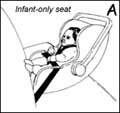 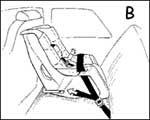 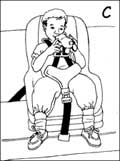 |
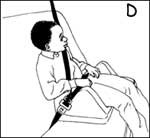 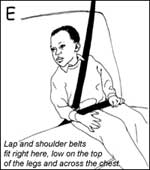 |
First Aid
Babyproofing is a great way to prevent accidents, but should the unthinkable happen, it's best to be prepared. Though each child and home is different, the following guidelines will help keep baby safe.
Poison
• Be sure to have a list of important telephone numbers, including poison-control 911, your pediatrician, etc., by every phone in the house.
• If your child ingests a dangerous and potentially poisonous substance, bring its container to the phone and immediately call your local poison control center. You will probably be asked to list the ingredients it contains and will be advised with what steps to take.
• If your child has swallowed a potentially dangerous substance, do not try to induce vomiting without checking with poison control first.
• If you are advised by poison control to go to the hospital, bring the container of what your child has swallowed with you.
Choking
• Learn to identify if your child is choking: if an object or piece of food becomes lodged in your child's windpipe, she will probably cough, wheeze, gag, or drool. If the object is completely blocking her airway, she will not be able to talk or cry and her face will turn blue.
• Do not try to remove an object unless you can actually see it. Blindly sweeping through her mouth with your fingers might result in pushing the object further down her airway.
• If you suspect your child is choking, call 911 or your local emergency number immediately.
Burns
• If a burn occurs, immediately plunge the burned area into cool water (never ice). Cover the burn with a cold, moist cloth for 15 minutes.
• Call your doctor to determine how to treat burns. First degree burns, characterized by mild redness, warmth, and discomfort, and second degree burns, which blister and ooze, can generally be treated at home with the advice of a physician. Third degree burns, characterized by charred skin, will need medical attention and must be treated at the hospital.
Safety Books and Videos
For more information about safety, please see our list of recommended books and videos about safety.
Jane Snyder has worked with children and children's products for the better part of her adult life. She was a child-care provider and a nursery school teacher's aid during her college years and spent five years as a children's book editor before becoming a toys and baby editor at Amazon.com.